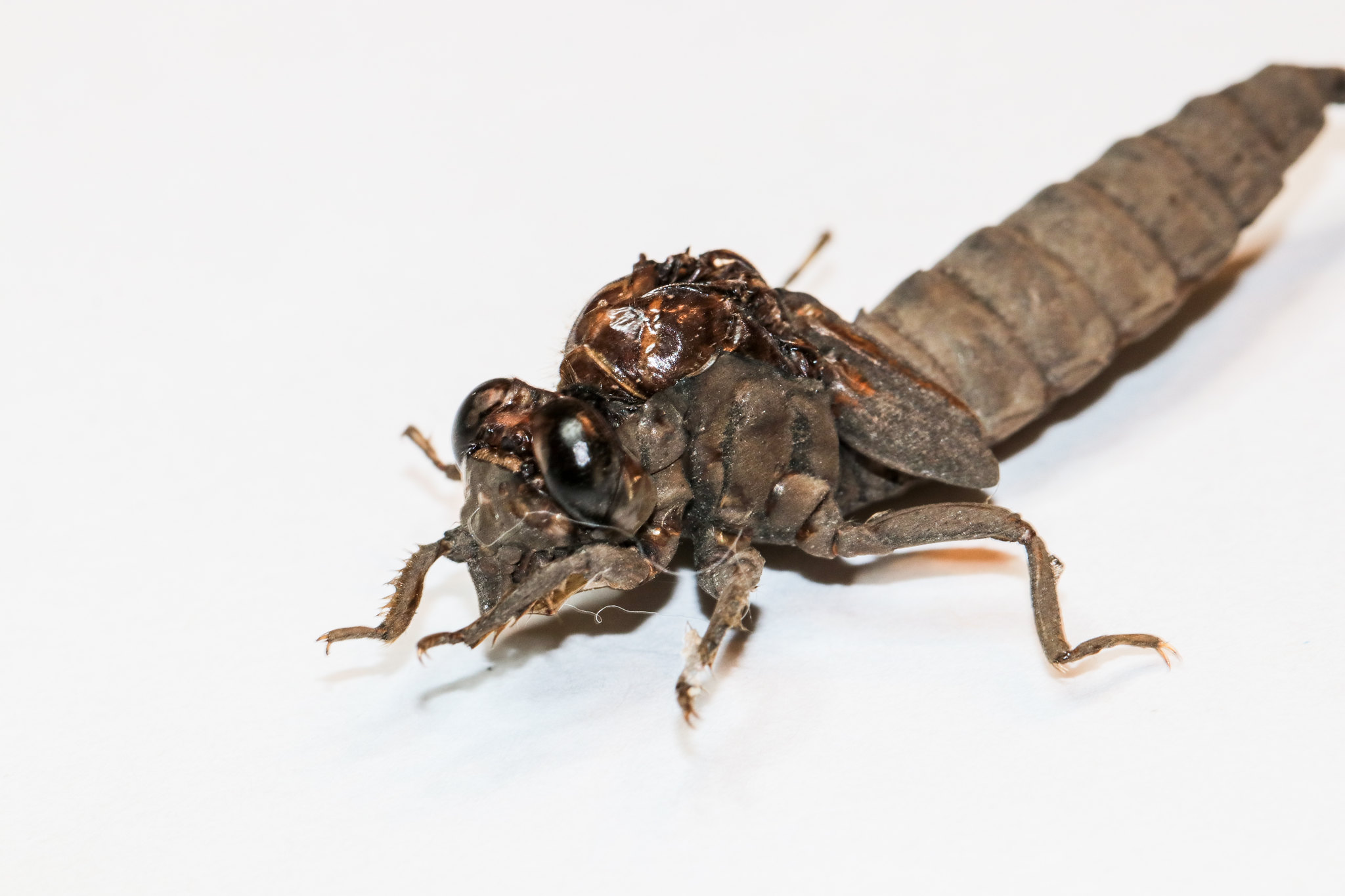Dragonfly and it's exuviae.
Jan 16, 2022 19:41:47 #
relbugman wrote:
Ahh! You made me learn something new! I've used ... (show quote)
Well Bob you are really not alone. Exuvia and exuvium are neologistic but I'm finding them used in modern books and studies. I've just always used exuviae.
At a weekend symposium dealing with Anisoptera there was a heated discussion concerning what immature dragonflies are called. I've always used naiads and I've always subscribed to the European usage of calling all immature insects larvae as opposed to American usage of calling hemimetabolous insects naiads, ametabolous and paurometabolous immatures nymphs, and holomatabolous immatures larvae. The discussion ended when someone in the back of the room said, Can we just all agree to call them babies and get back to the microscopes?"
As for the breathing of Anisoptera and propulsion, yes, water is drawn into the anus and oxygen is extracted or forcefully expelled jetting it forward. As I'm sure you know it has long been held that closing off the anus and again forceful contraction extends the labrium for catching prey. Two years ago at a remote talk a German scientist put forth an alternate theory that this is not a hydraulic movement but a mechanical event with the muscles of the labrium on tension as in a crossbow and released to extend the appendage. I really need to find out where that theory went.
>i< Doc
Jan 16, 2022 20:32:08 #
artesdecobo wrote:
Highly educational and great images. Thanks, Doc.
Bubba
Bubba
So glad you found it of interest and educational Bubba. I really appreciate you looking in and commenting.
>i< Doc
Jan 16, 2022 20:35:33 #
Sylvias wrote:
Very interesting narrative and great shots Doc. 





Thank you Sylvia. I'm glad you found it interesting. The shots of the exuviae I did handheld with a macro lens. I do need some practice with that. I hope you are well. Be safe.
>i< Doc
Jan 16, 2022 20:42:55 #
Mark Sturtevant wrote:
Very interesting, Doc! I am glad I caught this post. This may be a species where the immature stage breathes through a long snorkel while under water.
Actually all naiads breath by drawing water into the anus to extract oxygen. The Gomphidae will sometimes leave their muddy bottom and crawl up onto the land for short periods even before the ultimate instar. Yes they really are very interesting. You may want to check my reply to Bob (relbugman). Stay safe my friend and thanks for looking in and commenting.
>i< Doc
Jan 16, 2022 20:45:11 #
merrytexan wrote:
these are beautiful shots, doc, and interesting and excellent information as usual! 

Thanks Merry. I really need to practice more with lighting and using a handheld macro. Stay safe and well.
>i< Doc
Jan 16, 2022 20:58:27 #
I actually knew about 'naiad' but chose to simplify it, particularly as 'nymph' is used for apterygotes and neopterans that look more-or-less like adults, thus on both 'evolutionary sides' of palaeopterans. And the rectal uses.
But, I was really asking whether the anus was at the end of the tube (perhaps combining the epiproct and paraprocts that are used to close the anus in other naiads etc.), or if it was a modified sternite or tergite and the anus was above or below at the base. And Mark asked a related and very interesting question about snorkeling! That would mean a return to air-breathing through a pseudo-lung! In both cases it might function as a 'gimbal' and direct the jet and the reaction force. Defense by liquid thrust.
Oh, I had never heard of the hemostatic extension of the labium, always assumed it was muscle controlled, especially as it is an extension function of the mentum at both ends, at least I assumed. Sort of like the upper arm in throwing a direct punch. Every day there's less time to learn, so much to go!
But, I was really asking whether the anus was at the end of the tube (perhaps combining the epiproct and paraprocts that are used to close the anus in other naiads etc.), or if it was a modified sternite or tergite and the anus was above or below at the base. And Mark asked a related and very interesting question about snorkeling! That would mean a return to air-breathing through a pseudo-lung! In both cases it might function as a 'gimbal' and direct the jet and the reaction force. Defense by liquid thrust.
Oh, I had never heard of the hemostatic extension of the labium, always assumed it was muscle controlled, especially as it is an extension function of the mentum at both ends, at least I assumed. Sort of like the upper arm in throwing a direct punch. Every day there's less time to learn, so much to go!
Jan 17, 2022 15:22:11 #
Jan 17, 2022 15:27:05 #
Bubalola wrote:
WoW, Doc!
Thanks so much Eugene. I’m so glad you enjoyed it. Take care. >i< Doc
Jan 21, 2022 18:07:50 #
Thanks Doc! This post & the responses were very educational. Either way, if it's hydraulic, it still requires muscles to work, no?
Jan 22, 2022 06:55:53 #
Muddyvalley wrote:
Thanks Doc! This post & the responses were very educational. Either way, if it's hydraulic, it still requires muscles to work, no?
Hey Vic. The long held belief was that the anal opening was closed off with the terminal appendages and that the forceful contraction of the abdomen which normally ejects water from the breathing chamber to propel the naiad forward instead caused the labium to extend. I'm really going to have to dig into this a little more. There's always something to learn. Take care my friend.
>i< Doc
Jan 22, 2022 07:15:22 #
An interesting parallel: crab spiders use hemostatic pressure to extend their two front leg pairs out and back until a catch mechanism holds them open. Then they build muscle-powered closing against the catch, and when it is triggered by movement, released, the legs snapping forward around a potential prey. I think also used by click beetles (Elateridae) to snap upward. An elegant solution for a very fast movement. I'd suspect that the catch mechanism is also used by the naiads, but against muscle power rather than blood pressure, but ... ??? Please ppost your research findings - most interesting!
Jan 22, 2022 08:21:30 #
relbugman wrote:
An interesting parallel: crab spiders use hemostat... (show quote)
Interesting indeed!!!! Good information. Thanks.
>i< Doc
Jan 23, 2022 06:10:21 #
relbugman wrote:
An interesting parallel: crab spiders use hemostat... (show quote)
Well Bob, I read a lot of studies on the subject. Some old and some new and the one below seemed like the most plausible and extensive study. Evidently there are no muscles that alone can produce the speed or force of the offensive or defensive extension of the labium and it appears to be a combination of muscular and hemostatic pressure that is responsible. Many other studies still claim that in their conclusions the process is not completely understood.
https://www.google.com/url?sa=t&rct=j&q=&esrc=s&source=web&cd=&ved=2ahUKEwi8mcDvxcX1AhW4JEQIHcMjAMUQFnoECCQQAQ&url=https%3A%2F%2Fciteseerx.ist.psu.edu%2Fviewdoc%2Fdownload%3Fdoi%3D10.1.1.993.3804%26rep%3Drep1%26type%3Dpdf&usg=AOvVaw1Is6YHKT_CTff8eaFlxXA8
>i< Doc
Jan 23, 2022 06:12:07 #
If you want to reply, then register here. Registration is free and your account is created instantly, so you can post right away.







